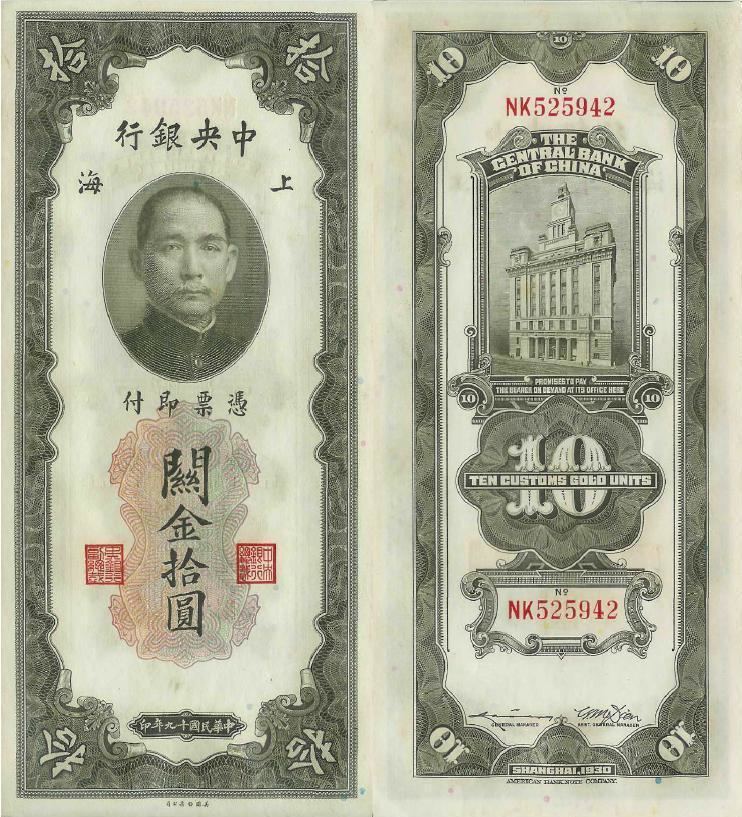10 customs gold units 20 customs gold units Coins None Central bank Central Bank of China | 1/100 cent (分, Fen) User(s) Republic of China | |
 | ||
Banknotes 0.10, 0.20, 1, 5, 10, 20, 50, 100, 250, 500, 1000, 2000, 2500, 5000, 10 000, 25 000, 50 000, 250 000 CGUs | ||
The customs gold unit (CGU) was a currency issued by the Central Bank of China between 1930 and 1948. In Chinese, the name of the currency was 關金圓, literally "customs gold yuan" but the English name given on the back of the notes was "customs gold unit". It was divided into 100 cents (關金分). As the name suggests, this currency was initially used for customs payments, but in 1942 it was put into general circulation for use by the public at 20 times its face value in terms of the first Chinese yuan.
Contents
History
The customs gold unit was adopted on 1 February 1930 to replace the Haikwan (Hǎiguān) or Customs tael (海關両) as the standard for customs payments. It was defined as equal to 601.866 mg fine gold or US$0.40. CGU notes were fully backed by silver and were legal tender for paying import duties. The CGU replaced the Haikwan tael at CGU150 = HkT100.
The CGU's value, fixed against the US dollar, fluctuated against the Chinese yuan, based on the current yuan–dollar and yuan–sterling market exchange rates. After the UK abandoned gold in September 1931, only the yuan–dollar rate was used until 1933, when the sterling price of gold in the London market determined the value of the CGU. Central Bank of China sold CGU notes at the prevailing quotation so that businessmen could minimize exchange risks resulting from changes in the yuan–dollar and yuan–sterling exchange rates. Use of this currency was very limited, with only about CGU375,000–475,000 outstanding at the time of the 1935 currency reform.
The Chinese currency reform of 3 November 1935, which created the Chinese national yuan or dollar (CNC$), commonly known as the Chinese legal tender dollar or fapi in English (Chinese 法幣; Pinyin: fǎbì), also fixed a crossrate of CGU100 = CNC$226.
The CGU's role in paying custom duties disappeared in 1941 when the government set ad valorem customs rates. On 1 April 1942 the custom gold unit's theoretical gold content was raised to 888.671 mg fine gold, equal to one US dollar. In practice, the customs gold unit lost all its special features and simply became equivalent to 20 Chinese legal tender dollars (CGU1 = CNC$20).
When Nationalist troops and officials arrived in Shanghai in 1945, they brought with them newly printed notes of 20 and 50 customs gold units. These notes proved more popular locally than Chinese legal tender notes and, due to a mistaken belief in the existence of a gold-redemption clause, they commanded a premium when exchanged for Central Reserve Bank notes of the Nanjing National Government. CGU notes circulated alongside ordinary legal tender notes until 1948, when both were replaced by the gold yuan at the rate of 1 gold yuan = 3,000,000 Chinese legal tender dollars = 150,000 customs gold units.
Other uses
The Flying Tigers, an American Volunteer Group of pilots and ground crew that operated within the Chinese Air Force in 1941 and 1942 during World War II, was also paid in this currency.
